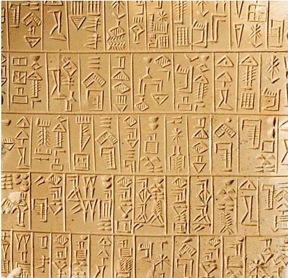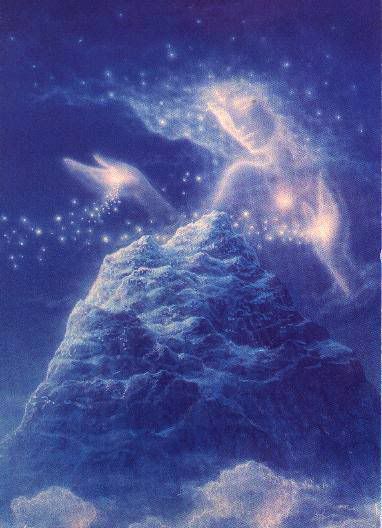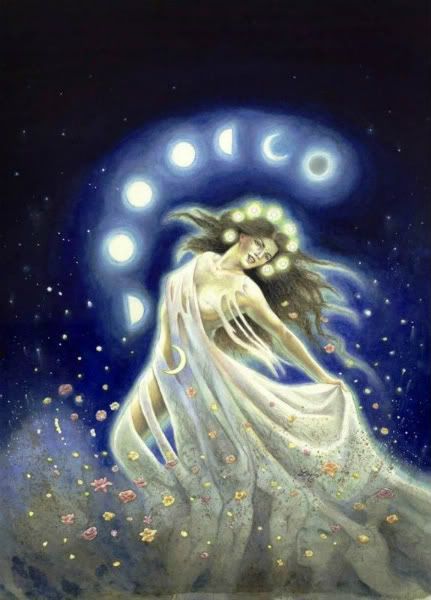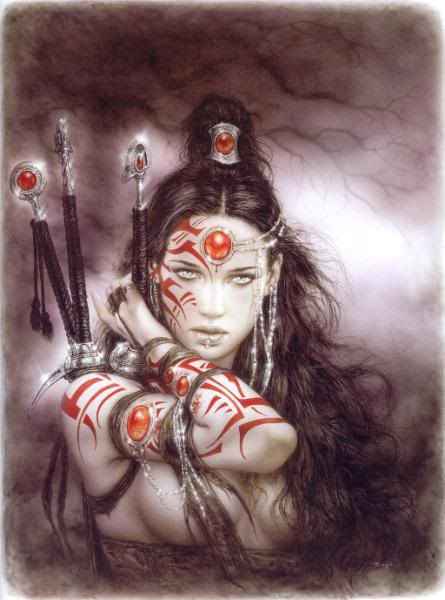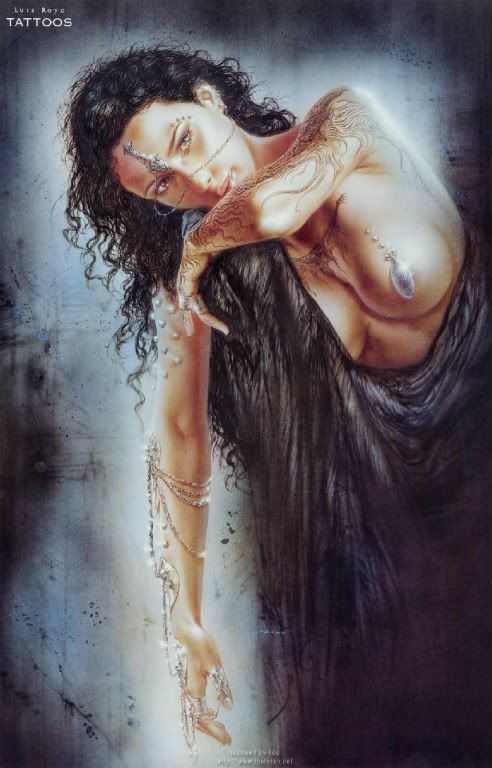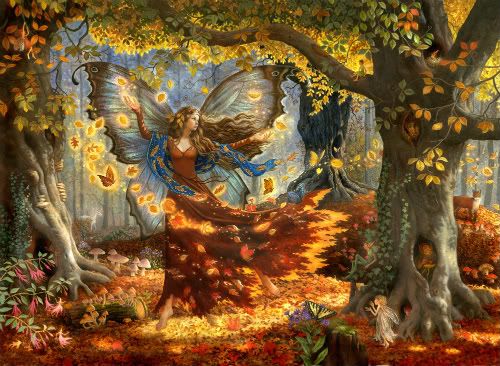
As Faerie, the tween times have always been mine. I have always belonged to the dusky twilight and the late autumn, the blustery, stormy days filled with a dark blue ocean of clouds and to the sunsets and dawns wonder-woven with bright golds and flamingo tangerines, richly-bruised by purple and periwinkle with the settling night and the oncoming day. I have always belonged to these times. They shape my senses and sentiments, connecting me to the spheres, the spiral and the Goddess. Their quiet, windswept, shimmering song fills me with love and life, spirit and power, serenity and joy. It has always inspired me to dance deeply upon the spiral, and it has always been my own.
Autumn is one of the four temperate seasons, and my favourite. It is the cusp of the shifting from summer into winter, and the time of year that the arrival of night and the setting of the sun become noticeably earlier. The autumnal season was once called "the harvest", before the word harvest lost its connection to the time of year, and came to connote the actually activity of reaping during this time only. The word autumn as well as fall began to replace its connection to this seasonal time. The alternative word fall is a contraction of Middle English expressions meaning "fall from a height", "fall of the leaf" and "fall of the year". It is the exhaled breath of the Crone, unlike the inhaled breath of the Maiden, or the full, held breath of the Mother, or the empty, suspended breath of the Dark Lady.
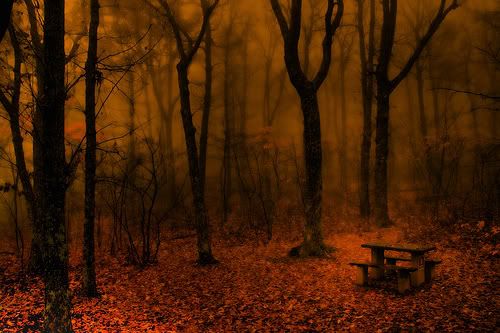
Autumn is associated with the change from warm weather to cold weather. It is the season of the harvest. Personifications of autumn are usually beautiful, voluptuous females, well-fed and well-endowed, amply adorned with the fruits, vegetables and grains that ripen at this time. Many cultures feature autumnal harvest festivals, and extant echoes of these celebrations include the mid-autumn Thanksgiving holiday and also the many North American Indian festivals tied to the harvesting of autumnnally ripe foods gathered in the wilds. While most foods are harvested during the autumn, foods especially associated with the season include pumpkins and apples, which are used to make seasonal foods and beverages such as apple cider and pumpkin pie, and are integral and prevalent parts of both Thanksgiving and Halloween, or Samhain, the third and final harvest festival in the Wiccan wheel of the year.
It is little wonder then that I adore pumpkin-pecan and apple pies, liberally laced with cinnamon of course, and spiced apple cider and nutty honey mead, and any candle, incense or oil that carries the scent of them. Any faerie would, and all faeries do. The pervasive mood of these autumnal festivals is also one of my favourite tween times. It is a gladness for the fruits of the earth coalescing with a melancholia connected to the imminent arrival of a harsh winter. It is a perspective presented in the English poet John Keats' poem To Autumn, describing the season as a time of bounteous fecundity and a time of mellow fruitfulness. It is bittersweet and heavily nostalgic, poignant and raw, piercing and beautiful.
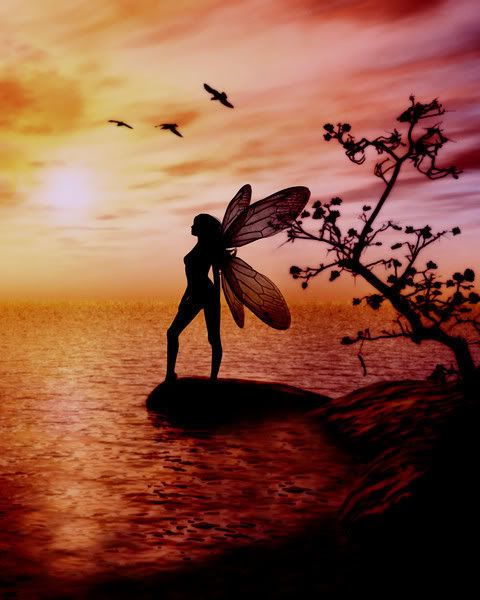
Autumn in poetry has often been associated with melancholy. The possibilities of summer are gone and the chill of winter is in the air. Skies turn grey, and many people turn inward, physically and mentally, emotionally and spiritually. The song of Autumn is characterised by strong, painful feelings of sorrow, where the maturation of the world has reached its prime and it now must look ahead to the inevitability of old age and death. The autumnal season is a tween time, emphasising and echoing both lushness and abundance, but also a sense of melancholia and reflection.
Autumn is also associated with the Halloween holiday, which in turn was influenced by Samhain, a Celtic autumnal festival and a seasonal sabbat of the Wiccan wheel of the year. Samhain is my favourite Sabbat followed by Litha and Yule. The thing I love most about these tween times in the changing of the colours of the leaves, and the colourful autumnal foliage - from the lustrous golds and bright oranges to the burnished titian reds and dark earthen browns. They are redolent and resonant of the colours of my soul's tapestry. In indian mythology, autumn is considered to be the season for the Goddess of learning, Saraswati, who is also known by the name Sharada, Goddess of Autumn.

Twilight is one of my favourite words. It is so shimmering and surreal, so whimsical and ... Faerie. It is the time between dawn and sunrise or between sunset and dusk, during which sun's light scatters in the upper atmosphere, illuminating the lower atmosphere, and the surface of the earth is neither completely lit nor completely dark. The sun itself is not visible to the eye because it is below the horizon. The special energy of the ambient light at this tween time, like a mantle over the lands, is powerful and beautiful, magickal and motherly, whimsical and wondrous, eerie and still. These tween times are the season of Witch, She who exists in places not places, and times not times, and realms within realms, and beyond. Twilight is sacred in Hinduism. It is called cow dust time. Many rituals including Sandhyavandanam and Puja are done at twilight. Just like with autumn and in Indian mythology, Hindus believe that this time is ideal for study and education.
I love overcast days. It feels like the world has turned topsy-turvy upside down on its head, draped over with a veil of mist and fog, so that the sky is an ocean of clouds, and the sea is a sky of dark waters, and all is blustery and stormy and grey. Overcast is that wonder time when the clouds, dark and heavy with unfelled rain, obscure the bright heat of the sun with a pale, muted, haze of grey. It is neither hot nor cold, but cool. It is neither bright nor dark, but dull. It is neither sharp nor blinding, but indistinct. It is like the Dreaming. It is like Otherworld. It is like home.
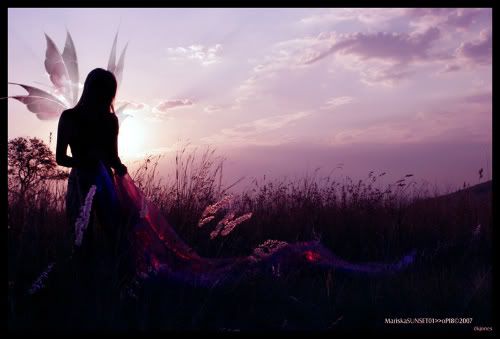
Dawn in the time that marks the beginning of twilight before sunrise. It is herald by the presence of pale sunlight, though the sun itself is still below the horizon. Many Indo-European mythologies have a goddess of the dawn, separate from the male Solar deity, derivations of which include Greek Eos, Roman Aurora, Indian Ushas, the Hindu male dawn deity Aruna, the Native American Anpao, entity with two faces, and hailing from my very own pantheon, the Slavic Zorya or Zornitsa.
In Slavic mythology The Zorya are ancient Slavic sky and light goddesses, honoured particularly in Russia. They are three Slavic dawn goddesses. They are also guardian goddesses, known as the Auroras. They guard and watch over the doomsday hound, Simargl, who is chained to the star Polaris in the constellation Ursa Minor, the "little bear". If the chain ever breaks, and the hound should ever get loose, it will devour the constellation and the universe will end. The Zorya represent the Morning Star, the Evening Star and the Midnight Star.
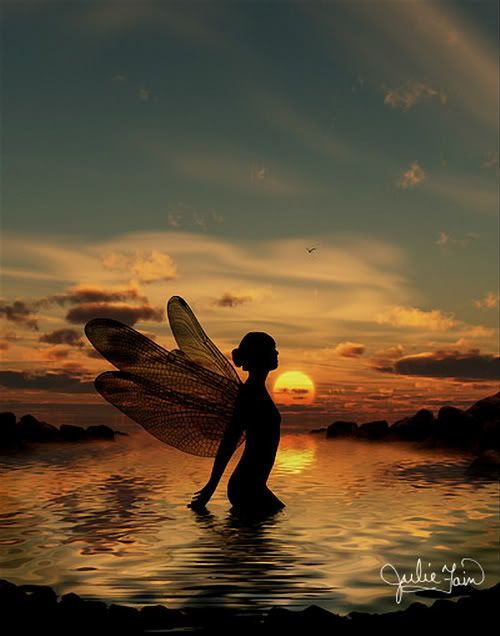
Sunset is the daily disappearance of the sun beneath the horizon. The brightly-spun apricot and auburn hues are stunning, and the afterglow of the setting sun sinking into the blues where the sea and sky kiss is exquisite. Little can compare to its beauty, for it is the beauty of Goddess herself, and it is divine. Sometimes just after sunset a flash of green can be seen across the face of the still waters. This is a moment of power and of wonder and of magick. To make a wish on the green flash is to move the entire universe to do your bidding. You are blessed to lay eyes on it even once in a lifetime.
These tween times - the times between summer and winter, between day and night, between sun and rain, dawn and sunrise, sunset and dusk, ekstasis and melancholia, are mine. They are mine because they are Faerie and because I am Faerie and because they are home. I belong to their fallen leaf wishes and lovely spicy scents, to their melancholic moods and colourful tones that cause me to reflect on my nature, and on the nature of the Divine. I belong to their beauty and their bluster, to their energies and their enigmas. They are my own.
Brightly-spun, wonder-woven,
Lady Faemore Lorei


